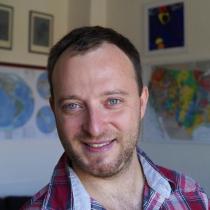CLR person interests, research and publications
Researcher

About me
Ondrej Kryza finished his Phd at the Charles University (Faculty of Science) and his post-doc at the Institute of Geophysics (Czech Academy of Sciences).
During bachelor and master studies, he was interested in the numerical approach of large-scale geodynamical systems. Diploma thesis was focused on application of multivariate statistics to investigation of crustal diapirism based on Rayleigh-Taylor instability evolution.
During doctoral study at the Charles University, he continued with analogue and numerical modelling of the lithosphere-scale deformation in the collisional systems and also studied the effect of associated heat transfer and melt migration. Core of the dissertation represent models of the oroclinal buckling, detachment folding and crustal inversion induced by gravitational instability. The second part of the thesis is related with the modelling and investigation of sedimentary volcanism and propagation of mudflows under the Martian (low-pressure) atmospheric conditions.
Research interests
- Detachment/diapiric folding of the crust as a response to the indentation tectonics
- Melt migration through the deformed rock-multilayer on various space/time scales
- Oroclinal buckling of large orogens
- Modelling of salt diapirism (investigation of caprock dynamics on Zagros salt diapirs)
- Advanced applications of the photogrammetry and PIV in the analogue models, f) Sedimentary and cryo- volcanism at surfaces of various planetary bodies in the Solar system.
- Main tools: Analogue modelling, particle image velocimetry, advanced photogrammetry, structural geology, low-pressure experimentation, numerics
Research projects
The growth of eastern Pangea involves three contrasting orogenic cycles: 1) Baikalian cycle (570-540 Ma) consists of accretion of peri-Rodinian continental, Mirovoi and Panthalassan oceanic fragments to the Siberian margin followed by extensional HT reworking, the growth of magmatic arc, giant accretionary wedge and intraoceanic basin. 2) Altai cycle is typified by crustal thickening followed by syn-extensional melting of the accretionary wedge (420-380 Ma) and the opening of Mongol-Okhotsk ocean.
